 ANTIGUA ANTIGUA |
No other town has the charm and appeal of Antigua Guatemala. From its colonial architecture to its beautiful surroundings, this town is considered to be one of the most beautiful in Central America.
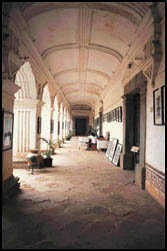
Founded in 1543, Antigua was once the third most important Spanish colony in the Americas, ruling over what is now southern Mexico and all of Central America. More than 30 monastic orders called Antigua home and built stunning monasteries, convents and cathedrals in the town.
The story of Antigua's arrival to the site where it presently lies is a rich story that plays itself out like a novel full of adventure, conflict and passion. The first town was founded near the Maya city of Iximché. It was soon abandoned when the Kaqchiquel residents rebelled at the Spanish demands for gold. The Spanish moved their capital to the valley between the Agua and Fuego volcanoes. But fate was against them and the town was swept away by a flood. Soon after the town was moved to its present day location where it has stood for more than 400 years.
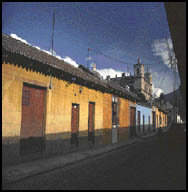
After a particularly devastating earthquake in 1773, the capital of Guatemala was moved to Guatemala City and Antigua was virtually abandoned. It wasn't until the late 1800s, that Antigua was virtually rediscovered and interest in the colonial city reawakened. The surrounding countryside became the focus of coffee farmers and the valley once again became prosperous.
Named a World Cultural Heritage Site by UNESCO, Antigua brings visitors to its cobblestone streets by the hundreds. Some come to visit the town and wander through its ruins, while others come to take advantage of the many Spanish schools.
No matter the visitor's reason for visiting Antigua, there are few that leave the town without heaving a sigh of regret. Its picturesque streets, richly textured ruins and friendly residents work their way into the heart of any visitor and remain there for quite a while.
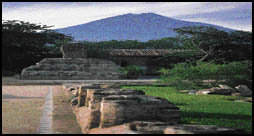
Today's Antigua is a cosmopolitan town that somehow manages to conserve its small town ambiance. Its streets are quiet enough for artists to set up their easels and attempt to paint or sketch their perspective of a particular church on paper.
Another facet to this town is the educational scene that plays itself out. Aside from a wealth of Spanish schools, the town boasts a fine library and research institute for visiting archaeologists. Here scholars may travel back in time and read about the many churches, convents and homes that once bustled with colonial activity. Visitors will also find the town to be a cultural center. A biennial arts festival is hosted here and showcases ballet, opera, symphonic orchestras and theater.
In recent years, a host of restaurants and hotels have opened their doors on these quiet streets. While they all hold to the small town atmosphere, they welcome an international crowd of both vacation and business travelers.
From typical Guatemalan cuisine to Italian dishes, restaurants cater to their guests with first-class service and hospitality. Many of these are located in renovated buildings complete with indoor patios and fountains. Whether you're there to enjoy a good meal or a cocktail, the ambiance is comfortable and pleasant.
The hotels in Antigua are varied and accommodate every budget. Quaint bed and breakfasts make you feel like an antigueño as you enjoy a typical breakfast on a flower bordered patio! Still other hotels offer European-style spa facilities complete with aromatherapy and relaxing Swedish massages.
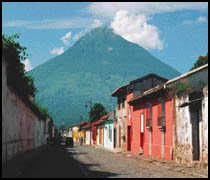
There are plenty of activities for the visitor to experience while staying in Antigua. The town itself offers a wealth of churches and ruins where you can while away the hours. Visit a bevy of museums that showcase original colonial art, silverwork and religious statues. The Museum of Santiago contains colonial ceramics, ironwork, a cannon and a sword used by Pedro de Alvarado. A book museum in the same building, which once housed the country's first printing press, details the history of printing.
The grounds of Casa Santo Domingo are a treat to walk through. This first-class hotel is located in a monastery that dates back to the 1500s. One of the richest in Antigua, it once held a sumptuous collection of colonial artwork. Today, visitors can wander around the beautifully manicured grounds and see how the monastery was laid out. The hotel also offers a tour through a small museum that houses colonial art and archaeological artifacts.
For a more active way to spend a day in the area of Antigua, take advantage of the many tour operators that run out of here. Mountain bike tours in the surrounding hilly countryside are a great way to explore the area. Outlying towns offer fabulous shopping for those interested in textiles, ceramic and woodwork. Those eager for adventure can scale the Agua or Pacaya volcanoes for a dramatic view from their cones.
 How to get there How to get there |
From Guatemala City, take the Roosevelt Boulevard out past Mixco. The highway is three lanes and boasts quite a few curves. The drive to Antigua takes approximately 45 minutes to an hour. There are extra-urban buses that make the run to Antigua, and while not uncomfortable, several stops are made, thus increasing the time to about an hour and a half. |  Climate Climate |
During the rainy season (mid-May through early October), the skies are virtually clear during the morning hours. The afternoon usually brings showers that can last for a few hours. It's a good idea to bring along rain gear, although the lighter.the better. The dry months boast temperatures that range from 75 to 80 degrees F, with temperatures rising a bit during the months of March and April. Evenings can be chilly with temperatures dropping noticeably during the coldest months of December and January.
 Getting Around Getting Around |
There are several car rental agencies in town but most visitors rent in the city and then drive out to Antigua. Local bus service is quite good both locally and also if you're on your way to Chichicastenango, Atitlán or other areas. A few travel outfits rent bicycles for those who plan on sticking around for a few days. These are great for getting around town even though Antigua's streets are ideal for walking. Taxis are plentiful and can be found around the Central Plaza.
 Semana santa Semana santa |
Semana Santa, or Holy Week, in Antigua is a truly memorable experience.
For its centuries-old traditions, for its beauty and complexity, Guatemala's Antigua shines among all the towns and villages that celebrate Holy Week.
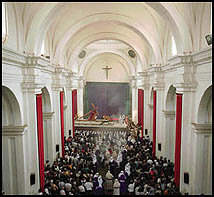
The history of processions in Antigua dates back to the early 1500s and began with the arrival of Don Pedro de Alvarado from Spain. After a series of calamities, which included the death of Pedro de Alvarado and the virtual destruction of the town by flooding, city officials took it upon themselves to move the town to its present day location. The first procession in Guatemala took place on that day as the town's survivors made the trek into the valley. They carried their personal possessions and the Holy Sacrament from the town that had been reduced to rubble.
Today, Antigua becomes a mecca of sorts for Guatemala's faithful during Easter celebration. Activities begin on Ash Wednesday, the first day of Lent, and reach their climax on Good Friday when the quiet town's streets are thronged with solemn spectators. It is well known to the locals that if you want to get around on Easter Sunday and witness the breathtaking imagery of a procession, you'd better get out there early. And if you're in a car, forget it. The procession routes shut down all traffic. Only pedestrians are allowed. Purple bows are tied onto window ironwork and often signify that it is on a processional route.
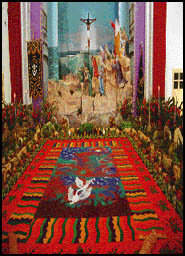
Carefully designed, hand-made carpets cover the cobblestone streets. Made from dyed sawdust and sand, flowers and fruits, the carpets, or alfombras, are veritable works of art that are brief in their beauty. Templates are made from wood or thick cardboard and the painstaking process of carefully designing the carpets begins hours before the procession. Parishioners who take the task to heart and unleash their creative talents take on the elaboration of the carpets. Residents and parishioners alike share coffee and conversation, as the temporary artists lay on low-slung boards that allow them access to their grand cobblestone canvas.
The atmosphere is truly unique. Not only is the air charged with anticipation, but it is also redolent with the fragrance of flowers and copal incense. The crowd's murmur reaches a crescendo as the procession rounds the corner. The spectacular carpet with bands of yellow, magenta and purple disappears under the shuffling feet of the bearers. Signs of the cross and genuflects flow through the spectators like waves on a pond.
Massive wooden platforms bear the statues of Jesus of Nazareth and the Virgin Mary. The bearers walk in ponderous synchronically as they proudly take the figure on its route. The floats are decorated with colorful flowers and richly textured fabrics; the regal statues are immaculately dressed and adorned.
The bearers of the floats are called cucuruchos and are often the same ones that carry a particular float year after year. But the bearing shifts are open to all weeks in advance in preparation for a procession. Many times the bearers are doing penance and seek atonement by carrying the heavy platform for blocks. All bearers pay a small fee to the church for the privilege and the money is used to decorate the saint and the float. Each church organizes its procession and it departs with much pomp and circumstance on its own route. Often the processions trundle for hours through the streets with bearers trading places at the end of every block.
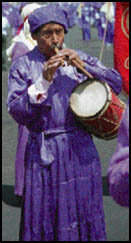
Locals and travelers alike can enjoy the festivities of Holy Week in Antigua. On every Sunday during Lent, several churches organize small processions. On Good Friday, onlookers bear witness to a Roman soldier as he reads the sentence of crucifixion for Jesus.
Most of the country's residents have a holiday from work from the Wednesday before Easter Sunday until the following Monday. During this time, residents take advantage of the days off to follow processions from their church around the city streets.
These processions are celebrated throughout the country in even the smallest town or village. Although all the celebrations are beautiful, Antigua rises above them not only for the elaborate processions, but also for the spectacular surroundings. The ruins of ancient churches, monasteries and convents provide a most stunning backdrop to these passionate pageants.
All these informations are provided by courtesy of Destination Guatemala and Sol y Luna |

